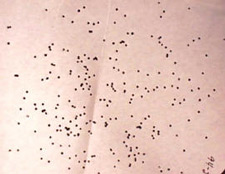- 01: Introduction
- 02: History
- 03: Propellants, Firearms, and Ammunition Development
- 04: Modern Firearms Manufacture
- 05: Small Arms Ammunition
- 06: Evidence Handling Procedures
- 07: Equipment and Instrumentation
- 08: Examination of Firearms
- 09: Cartridge and Shotshell Examination
- 10: Characterization and Evaluation of Fired Projectiles
- 11: Bullet Comparison and Identification
- 12: Gunshot Residue and Distance Determination
- Introduction
- Objectives
- AFTE Knowledge and Ability Factors
- Powders and Residues
- Examination
- Distance Determination
- Significance of Results
- Contact Shot
- Nitrite Residues
- Vaporous Lead Residues
- Residues Consistent with the Passage of a Bullet
- Residues Consistent with the Discharge of a Firearm
- Interpretation Challenges
- Reproduction of Results
- Nitrite Residue Patterns
- Shot Patterning
- Chemical Testing
- Shot Pattern Reproduction
- Selected Bibliography
- 13: Toolmark Identification
- 14: Communicating Results
- Resources


Shot Patterning
Home > Gunshot Residue and Distance Determination > Distance Determination > Shot Patterning

Portion of a shot pattern
The shot pattern analysis process pertains to firearms that fire multiple pellets. Pellet patterns can be measured for a much greater distance than those discussed previously. Distance determinations based on shot patterns are dependent on the reproduction of the physical environment where the shooting occurred. This means that the suspect firearm must be obtained; the ammunition used by the suspect must be identified and duplicated; and a questioned or evidence shot pattern must have been recovered, such as a victim’s garment or other object.
Although shot patterns in victim’s garments or other objects are normally visually examined and chemically processed for the presence of nitrite compounds and lead, the basis for most distance determinations is based upon the size of the shot pattern and pattern reproduction.
Pellet patterns may be elongated in shape because a relative angle of other than ninety degrees existed between the barrel of the firearm and the area of impact at the time of discharge. While it is relatively simple to determine the presence of such an angle, it is unlikely that any precise determination of the angle is possible. The comparison should be focused on the more narrow dimension of the pattern.
In patterns involving larger size pellets as found in buckshot, the resulting pattern may have fewer holes than the expected number of pellets in the load.
A buckshot pattern may have fewer holes present as a result of one or more of the following:
- Multiple pellets could pass through a single hole.
- An intermediate object may be involved at the time of discharge.
- Factory loaded shotshell may not contain the number of pellets indicated by the manufacturer.
| Note: |
| Handguns also can be loaded with various pellet loads, producing a shot pattern. |

Click here to read a sample forensic worksheet and report -
Gunshot Residue and Distance Determination (Shot Patterns)




